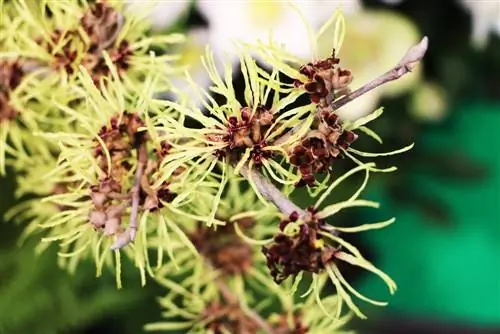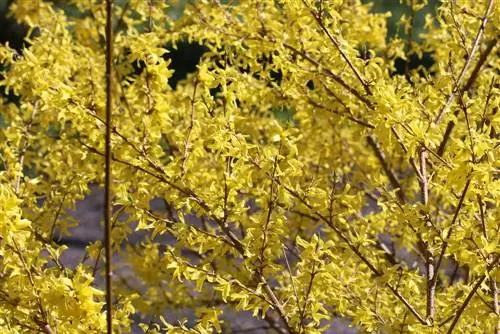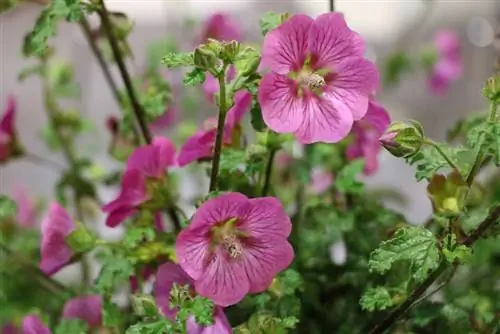- Author admin [email protected].
- Public 2023-12-17 03:39.
- Last modified 2025-01-24 12:45.
The witch hazel bush can truly enchant the garden. Because it blooms when others are still deep in hibernation. In order to maintain its splendor, the witch hazel bush needs some care.
Location
The witch hazel shrub requires a sunny location, but can also cope with light partial shade. Since it originally comes from the borders of sunny forests, it should also receive plenty of brightness in the garden. Although it even produces flowers in winter, this shrub cannot tolerate strong winds or cold drafts. It should therefore be given a somewhat protected location, for example on a house wall or in the wider area surrounded by other trees. However, it should not be transplanted too densely. The witch hazel bush cannot tolerate competition from other roots. Even small plants can quickly challenge him for water. Especially if it has just been planted. Therefore, underplanting should be avoided if possible, especially in the first three years of growth. The roots of the witch hazel only develop slowly, which is why this comparatively long period of time is necessary. However, flower bulbs and very small bushes may be planted.
Tip:
The witch hazel bush roots and grows relatively slowly, but will still reach an impressive size. You should therefore plan around 15 square meters for one shrub.
Substrate
The substrate must be very loose and permeable for the witch hazel. Otherwise, the roots will not develop properly and the expensive shrub will die. In addition, it is necessary that the soil both stores moisture and is rich in nutrients. A light, sandy substrate enriched with compost and horn shavings is recommended. So that watering does not become a chore and the witch hazel bush does not suffer from dryness, it makes sense to apply a thick layer of mulch. Bark mulch is ideal.
Plants

Once the right location has been found, all that remains is to choose the correct time for planting. Autumn is ideal, before the first frost. There is very little that needs to be taken into account. On the one hand, the shrub should not sit too deep; the root axis must be cut off from the surface of the earth. On the other hand, the floor should be covered with horn shavings. These promote the growth of the roots.
Care
The witch hazel bush grows slowly and needs to be carefully refined. Nevertheless, the maintenance effort is not too high. Only regular watering and fertilizing are required. If you save on this, there will be no flowering in winter.
Pouring
The witch hazel bush must be evenly moist, but it must not drown. In addition, care must be taken to ensure that water that is not too hardy is used. Rainwater or stale or filtered tap water is therefore best. Since a fairly large amount is required for watering - especially during the warm months - collecting rainwater is the cheapest choice. Applying a layer of bark mulch prevents unnecessary water loss. And the amount of water required is also reduced.
Fertilize
Fertilization is especially important in spring because flowering and cold require a lot of energy. It is therefore necessary to replenish the nutrient content of the soil in spring. The following procedure is recommended:
- Remove the old, used mulch layer.
- Loosen the soil.
- Mix compost and horn shavings evenly together and apply a thick layer of this combination.
- Water the applied fertilizer abundantly so that the nutrients can be absorbed into the soil immediately.
- Cover the fertilizers with a fresh layer of bark mulch.
Cutting
The witch hazel bush generally does not require any trimming. In fact, too radical an intervention can seriously damage the plant and result in an almost mutilated appearance. The reason for this lies in the woody interfaces. It is very difficult and rare for new shoots to emerge from these. So if a correction has to be made, then it should only be done cautiously and gently. It is ideal if only green shoots are separated in order to compact the bush or, in return, to thin out areas that are too dense.
Tip:
Use a wound closure agent and apply it to the incision sites. This prevents pathogens from gaining access here.
Implement
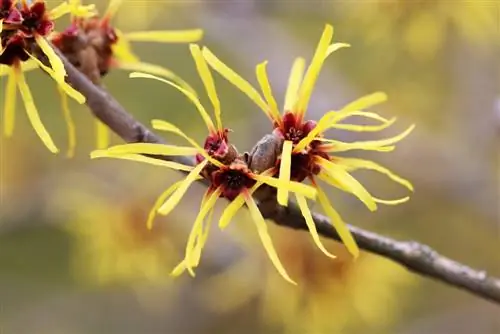
Relocating the witch hazel should only be done in an emergency, as the shrub can only tolerate a change of location poorly after its third year of existence. As a result, very targeted and close care is required. If you still have to move the shrub, you should make sure the root ball is as large as possible. A small excavator may be necessary for this.
Propagate
The witch hazel bush can be propagated in two ways. On the one hand, through the seeds, which fall around the time of flowering. However, this variant is very time-consuming and is rarely successful, even in temperate latitudes. On the other hand, through cuttings and cuttings, which are best obtained during budding in spring. This type of propagation is much easier, but still requires patience and some knowledge.
Cuttings and sinkers
Witch hazel cuttings are obtained by cutting off head shoots. Lowering points can be found in the immediate vicinity of the trunk. Young witch hazel bushes can be grown from them using the following procedure.
- Take off cuttings or dig up sinkers.
- Place the resulting shoots in a mixture of peat and sand and water well.
- Place the young plants in a bright and protected place.
- Keep the substrate evenly moist.
- If new leaves appear, which may take a few months, the propagation has been successful.
- The following year after budding, the grown plants are allowed outdoors. However, they require additional protection from wind and frost.
The success of this propagation is not guaranteed, and budding also takes a lot of time. Grafting would also be recommended, but this cannot be carried out without the appropriate specialist knowledge and a suitable second plant.
Tip:
Use a root aid, this will accelerate growth.
Wintering
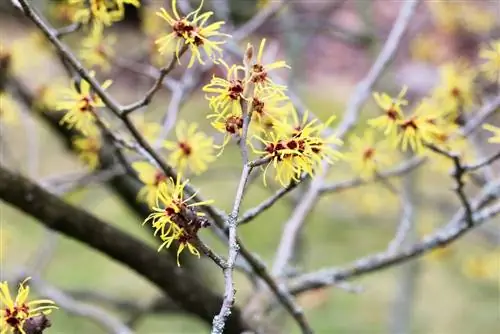
Because the witch hazel bush can withstand frost well, additional protection in winter is neither necessary nor recommended. During flowering, however, temperatures below -10 °C can still deprive the witch hazel bush of its beauty. The flowers don't disappear, but they appear pulled together and slightly wrinkled. A translucent windbreak can help here.
What you should know about witch hazel
- The witch hazel, known by its Latin name as witch hazel, comes from the witch hazel family, which only includes four species.
- Two species are native to North America, the others come from China and Japan
- The witch hazel is an almost magical shrub that can transform the garden into a winter wonderland, especially against an evergreen background.
- If it receives enough light, water and nutrients during the warm months, it is a great addition to the garden.
- Depending on the species, flowering begins in late autumn, with others not until January.
- The witch hazel reaches a height of between 3 and 5 meters.
- Although it is one of the most beautiful winter bloomers, it is rarely found in our home gardens.
- The bark of the witch hazel has a gray-brown color.
- The leaves on the star-haired branches are stalked, cove-shaped and the edge of the leaf has serrations.
- The leaves are easy to see thanks to their crooked blade base.
- The large stipules are also striking. A metallic sheen can be seen on the top of the leaf.
- The woody capsule fruits open with two flaps. Inside you will find two seeds that are black in color.
- The capsule opens explosively and the seeds it contains are thrown up to ten meters out of the capsule.
Although the plant does not place any special demands on its location, it should be chosen carefully. Basically you should plant the trees individually. Due to their appearance and coloring, locations with a dark background are recommended, for example in front of dark conifers, walls or evergreen deciduous trees. Although they are not sensitive to frost, you should choose a location that offers them some protection, especially from wind. A sunny and warm place should also be chosen.
- The best planting time is in the autumn months, after the leaves have fallen.
- When it comes to soil conditions, care should be taken to ensure that the soil is deep.
- Both humus soils as well as neutral or slightly acidic soils are recommended for witch hazel.
- However, the plant's growth is very slow. Once planted, witch hazel requires little care.
- The annual pruning of other plants should also be avoided when it comes to witch hazel. Only the wild shoots are removed regularly.
The leaves of the witch hazel are used in medicine because they have a high tannin content. These have an anti-inflammatory, hemostatic and astringent effect on the body. It is therefore used for inflammation of the skin and mucous membranes, minor skin injuries, complaints of varicose veins and hemorrhoids. In the past and still today in folk medicine, the plant was also said to have a healing effect on diarrheal illnesses. Accordingly, the leaves would also be used internally.

